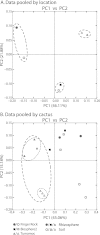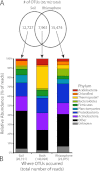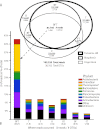Abiotic factors shape microbial diversity in Sonoran Desert soils
- PMID: 22885757
- PMCID: PMC3485727
- DOI: 10.1128/AEM.01459-12
Abiotic factors shape microbial diversity in Sonoran Desert soils
Abstract
High-throughput, culture-independent surveys of bacterial and archaeal communities in soil have illuminated the importance of both edaphic and biotic influences on microbial diversity, yet few studies compare the relative importance of these factors. Here, we employ multiplexed pyrosequencing of the 16S rRNA gene to examine soil- and cactus-associated rhizosphere microbial communities of the Sonoran Desert and the artificial desert biome of the Biosphere2 research facility. The results of our replicate sampling approach show that microbial communities are shaped primarily by soil characteristics associated with geographic locations, while rhizosphere associations are secondary factors. We found little difference between rhizosphere communities of the ecologically similar saguaro (Carnegiea gigantea) and cardón (Pachycereus pringlei) cacti. Both rhizosphere and soil communities were dominated by the disproportionately abundant Crenarchaeota class Thermoprotei, which comprised 18.7% of 183,320 total pyrosequencing reads from a comparatively small number (1,337 or 3.7%) of the 36,162 total operational taxonomic units (OTUs). OTUs common to both soil and rhizosphere samples comprised the bulk of raw sequence reads, suggesting that the shared community of soil and rhizosphere microbes constitute common and abundant taxa, particularly in the bacterial phyla Proteobacteria, Actinobacteria, Planctomycetes, Firmicutes, Bacteroidetes, Chloroflexi, and Acidobacteria. The vast majority of OTUs, however, were rare and unique to either soil or rhizosphere communities and differed among locations dozens of kilometers apart. Several soil properties, particularly soil pH and carbon content, were significantly correlated with community diversity measurements. Our results highlight the importance of culture-independent approaches in surveying microbial communities of extreme environments.
Figures




References
-
- Acosta-Martínez V, Dowds S, Sun Y, Allen V. 2008. Tag-encoded pyrosequencing analysis of bacterial diversity in a single soil type as affected by management and land use. Soil Biol. Biochem. 40:2762–2770
-
- Aguilera LE, Gutierrez JR, Meserve PL. 1999. Variation in soil microorganisms and nutrients underneath and outside the canopy of Adesmia bedwellii (Papilionaceae) shrubs in arid coastal Chile following drought and above average rainfall. J. Arid Environ. 42:61–70
-
- Allen JP, Nelson M, Alling A. 2003. The legacy of Biosphere 2 for the study of biospherics and closed ecological systems. Space Life Sci. 31:1629–1639 - PubMed
-
- Angel R, Soares MIM, Ungar ED, Gillor O. 2010. Biogeography of soil archaea and bacteria along a steep precipitation gradient. ISME J. 4:553–563 - PubMed
-
- Badri DV, Weir TL, van der Lelie D, Vivanco JM. 2009. Rhizosphere chemical dialogues: plant-microbe interactions. Curr. Opin. Biotechnol. 20:642–650 - PubMed
Publication types
MeSH terms
Substances
LinkOut - more resources
Full Text Sources

